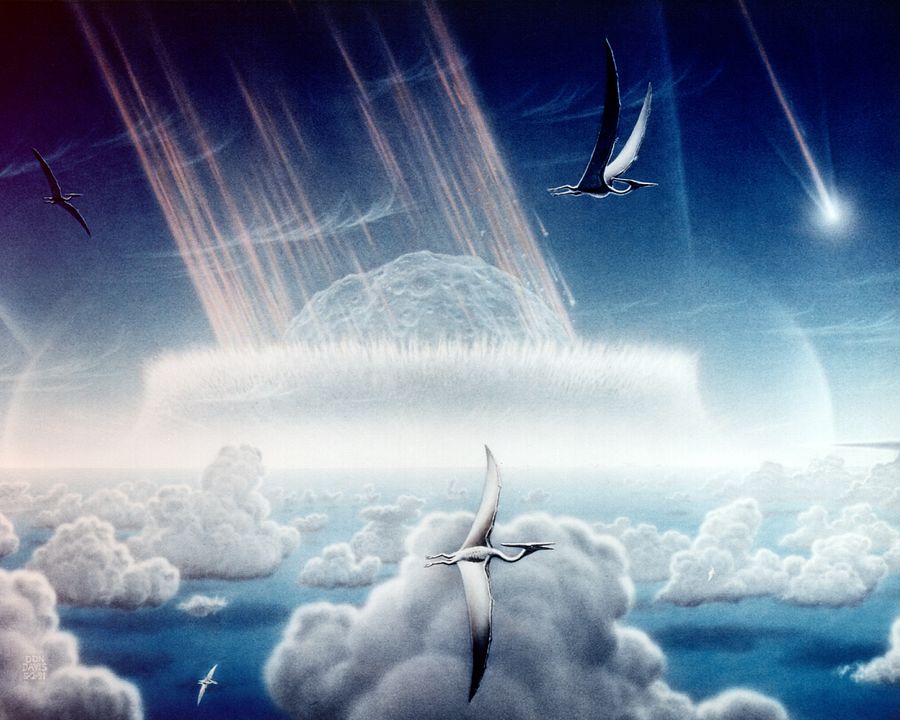
How big was the asteroid that killed the dinosaurs? It was probably 10 km across, but it could have been anywhere between 10 and 17 km.
The asteroid that killed the dinosaurs hit Earth about 66 million years ago. Apparently, according to research, it was 66,043,000 (±11,000 years). The asteroid came down in the Yucatan Peninsula in Mexico. It has left a crater that is about 300 km wide, with a 180 km inner ring, and is 20 km deep. The crater is called the Chicxulub crater because when it was found the closest settlement was Chicxulub Puerto. The asteroid was so large that it caused the Cretaceous-Paleogene extinction event that wiped out all of the dinosaurs. One of the six great extinction events.
The size, speed, and angle of the asteroid have all been calculated based on the impact crater. The impact of an asteroid changes greatly depending on its angle. This stands to reason. An impact at a low angle may glance off the planet, while an impact at a steep angle will be a head-on impact. A shallower impact angle produces a smaller crater. Calculations show that the Chicxulub crater was caused by an impact at 45 to 60˚, which is relatively steep. It is impossible to know the exact angle because the calculations need to know the size and the speed of the asteroid as well, none of which can be known for definite. It is also tricky because it is not clear where the exact center of the crater is, either. The angle of impact would affect the shape of the crater and the point of impact would be offset from the exact center of the crater by a certain percentage. Not knowing the exact center makes this difficult to calculate.
Scientists put a variety of different sizes, angles, and speeds into a 3D simulator and a 10 km asteroid travelling at 20 km/s impacting at about 60 ˚ made an impact crater that is most like the Chicxulub crater.
The asteroid would have been devastating. It would have travelled through the atmosphere in seconds and plowed into the Earth. The asteroid had the kinetic energy of 100 teratons of TNT, which is 4.5 billion times as powerful as the bomb dropped on Hiroshima.
When the asteroid hit, it punched through the surface of the Earth and rocks and other debris were blasted up into the atmosphere from the force. These rocks were carried all over the Earth and they have been found in a layer that is called the K-Pg (Cretaceous-Paleogene) boundary. The energy these rocks carried would have superheated the atmosphere, and up to 70% of the Earth would have burned. The ejecta travelled round the planet at about 16,000 km/h and the atmosphere below it heated up as it went. Once the temperature reached 70℃, most life that wasn’t underground or underwater died. The temperature could have risen as high as 150℃. Even if they weren’t killed by the direct heat, it would have killed a large amount of plant life. Fossil evidence of instant extinction has been found in New Jersey, which was 2,500 km away from the impact site.
The impact blasted a crater 30 km deep in the Earth. This would have held for a short while and then collapsed in on itself. When it collapsed there were shock waves that caused enormous earthquakes that could have reached a magnitude of 11. The area is under the sea and when the crater collapsed it also caused megatsunamis that possibly were 1.5 km high.
Most animals that survived the initial impact died very shortly after because of the nuclear winter. 25 trillion tons of rock, ash, and other material were thrown into the atmosphere. Coupled with this, a huge amount of Sulphur was also launched into the atmosphere because the rock under the sea where the asteroid struck was Sulphur-rich gypsum. The dust and Sulphur in the atmosphere blocked sunlight and global temperatures fell by several degrees. 75% of species on Earth died out. It is probable that many of the remaining 25% also died out.
The Chicxulub crater was discovered in 1978 by two geophysicists that were working for a Mexican oil company. They were prevented from publishing their findings by the oil company, but presented them at a geographic conference in 1981. At roughly the same time, a geologist called Walter Alvarez had put forward the theory that the K-Pg extinction was caused by an asteroid impact. Their evidence was the K-Pg boundary. The boundary contained high levels of iridium, which is rare on Earth but very common in asteroids. He looked in many places for the crater, but couldn’t find it. It took another 10 years before the crater at Chicxulub was suggested and it was only in 2010 that a team of 41 experts analyzed all of the available data and decided that it was the source of the dinosaur-ending asteroid. There are still alternative theories, and not everyone believes that the asteroid was the sole cause of the extinction, but the general consensus is that it was.
So, the asteroid that killed the dinosaurs was about 10 km wide, travelled at 12 km/s and hit the Earth at an angle of about 60˚. And this is what I learned today.
Sources
https://www.ncbi.nlm.nih.gov/pmc/articles/PMC7251121/
https://en.wikipedia.org/wiki/Chicxulub_crater
https://www.nhm.ac.uk/discover/how-an-asteroid-caused-extinction-of-dinosaurs.html
https://en.wikipedia.org/wiki/File:Chicxulub-animation.gif
https://en.wikipedia.org/wiki/List_of_impact_craters_on_Earth#Largest_craters_(10_Ma_or_more)
https://www.space.com/dinosaur-impactor-origin
https://en.wikipedia.org/wiki/Cretaceous%E2%80%93Paleogene_boundary
